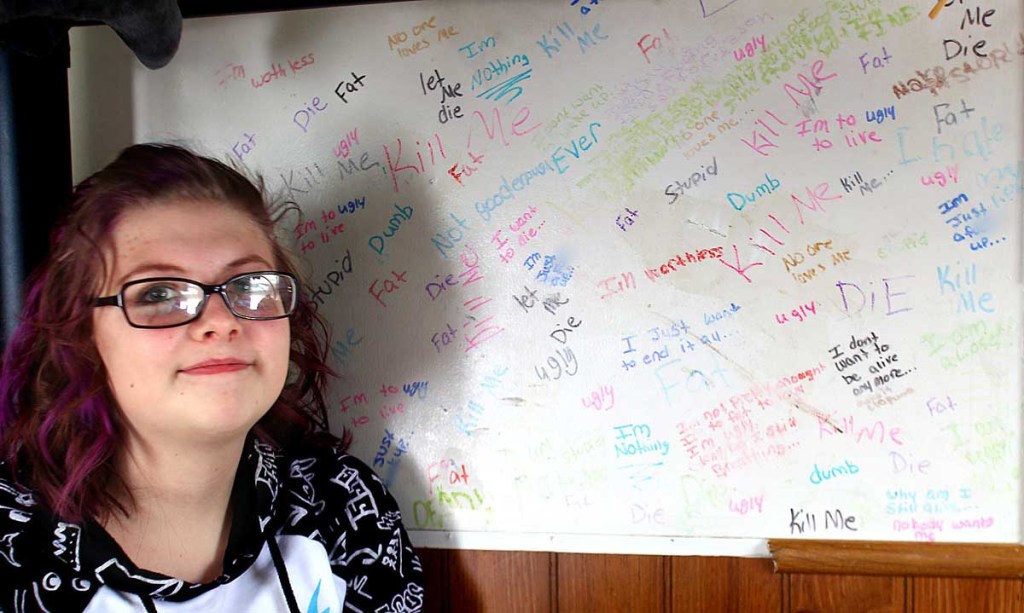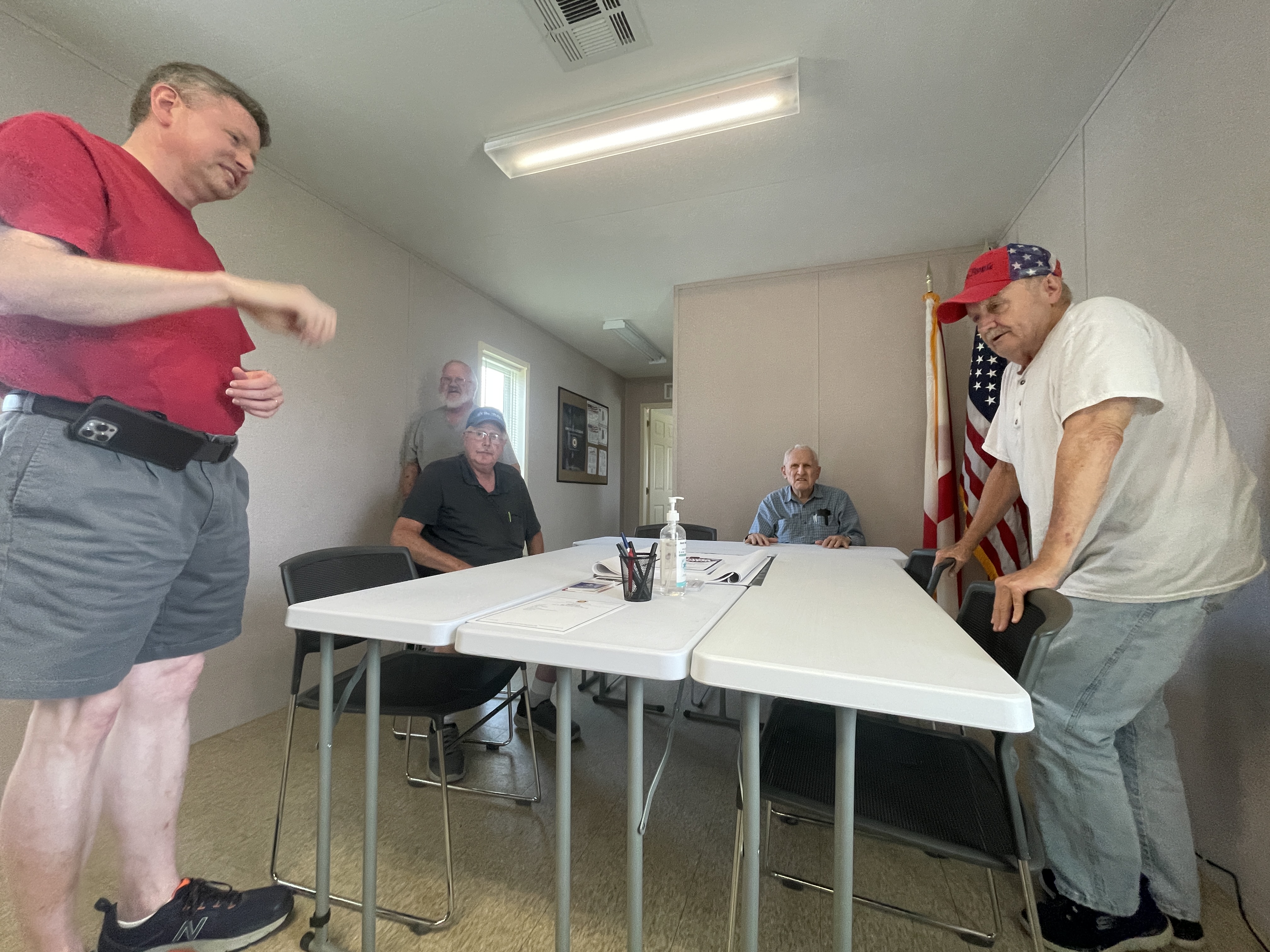Indiana teen’s experience highlights difficulties of dealing with bullying
Published 1:28 pm Thursday, February 18, 2016

- Baylei Frazee, 13, sits next to a wall in her bedroom where she wrote the negative messages other students directed at her.
Fat, stupid, worthless, too ugly to live.
Baylei Frazee, now 13, transferred the hurtful words hurled at her by classmates to the wall of her bedroom last school year as a way to process the negativity. But as the mass of words grew – written with different-colored Sharpies – Frazee became overwhelmed. She started self-harming in an effort to cope with her plummeting self-esteem.
“If something happened that day, I wrote a word on there,” said Frazee, who went through months of therapy to deal with her self-destructive tendencies. “It helped me get everything out. It was bad until I switched rooms.”
The bullying started in the 2014-15 school year, when Frazee was in sixth grade at Central Middle School in Kokomo, Indiana. Her mother, Megan Clark, and stepfather, Todd Lanning, say they contacted school administrators about the problem, but as the bullying persisted, they decided to transfer Frazee to Bon Air Middle School around September of 2014.
The harassment followed her there and has continued this school year.
In addition to illustrating some of the consequences of harassment, Frazee’s experience also brings to light the difficulty many schools face in defining, identifying and addressing instances of bullying, which can come in the form of verbal, physical, relational or written abuse.
As students increasingly interact with each other online, schools and parents have the added challenge of trying to monitor virtual interactions as well. Overall, more than 3.2 million students in grades 6 through 10 nationwide — nearly one in six — are victims of some form of bullying annually, according to the Southern Poverty Law Center. In Indiana, more than 7,000 cases of bullying in public schools were reported last year, according to data from the state’s department of education.
In Frazee’s case, Clark and Lanning think the school failed to enforce its bullying policy. At the end of January – after Frazee was physically attacked at school – they pulled their three children out of Kokomo Schools to homeschool them until they can move into another school district.
Defining bullying
School administrators cannot comment on instances involving specific students due to confidentiality issues. Even in cases of alleged bullying, school staff cannot tell a parent how the issue was resolved as it relates to the other students involved.
“It’s no different than telling you what another child’s grades are or where another child lives. I can’t divulge that information,” said Mike Sargent, assistant superintendent of Kokomo Schools. “That’s the student’s privacy. I can only talk about your child, what service we provide or the consequences and what their part in this was. I can’t talk about the other kids involved. That’s really frustrating to parents, and I get it.”
Kokomo Schools defines bullying as any “overt, unwanted, repeated acts or gestures … with the intent to harass, ridicule, intimidate or harm the targeted student and create for the targeted student an objectively hostile school environment.”
Other schools have similar definitions, and the key word there is “repeated,” says Cynthia Evans, who monitors how principals handle instances of alleged bullying in her role as director of social and student services.
“One-time incidents are not considered bullying,” she added.
Students, parents and any school staff members can report incidents they think may qualify as bullying, and the principal bears the primary responsibility in investigating what happened. Principals can interview students and involve parents to gather more information, Evans explained. They will report their findings and share them with corporation-level administrators, like Evans or the assistant superintendents.
School resource officers and other law enforcement officers only get involved if the principal believes a student’s actions could potentially be considered criminal activity. The principal would turn over his or her findings to the officer, who would then complete an independent investigation.
Ongoing disputes
Froze told the Kokomo (Indiana) Tribune she would get as many as 25 threatening messages a day from a dozen different girls, via text, Facebook, Instagram or Snapchat. She got nervous every time a notification showed up on her phone, wondering if it was another attack. Clark said she had Frazee change her social media accounts and phone number multiple times, but the other students would eventually find her new profile pages. Clark instructed Frazee not to respond to the messages; one of the screenshots of the threats made by other girls reference Frazee “posting stuff on Facebook and Instagram” about when she was physically attacked at school.
“She can’t ever just let it go and she can’t move past it and move on with it,” Clark said. “It will be over and done with for a week or so, and then somebody else will just message her and start it all up again. It just never dies down and goes away.”
Frazee also dreaded going to school, though she said the girls wouldn’t say as much to her in person as they did online. She had her class schedule changed to try to keep her apart from another girl whom Frazee says was leading the attacks.
Those two girls still had gym class together though, and on Jan. 13 the girl allegedly threw a ball at Frazee’s face and broke her glasses. Two days later, the same girl allegedly jumped on Frazee’s back and hit her in the eye. Clark took Frazee to the emergency room to have her bruised and swollen eye examined. That was the final straw, and they decided to homeschool Frazee and her siblings shortly after that.
Online activity
The virtual world opens up a whole new mode for students to communicate, and potentially harass each other, often away from adult supervision.
“This social media thing is the one that wears all schools out,” Evans said. “Kids are going to get online, they’re going to get on the phone. Students now use technology a little bit more than we want them to in that area.”
Parents have an important role in monitoring the online activity of their children, Sargent said, adding they should try to gather information on an entire conversation, not just a snapshot of what was sent to their child. Educators talk to students about the impact their online presence can have.
“Social media is a whole new realm,” Sargent said. “We just don’t have access to it.” he added. “Parents are really good at bringing stuff in. Sometimes a parent will report it as bullying, but what [the students] are both saying on the computer is shocking to both parents.”
Moving on
Frazee says she feels better now that she’s not attending school, but she’s still not completely removed from online contact with her former classmates. She’s worked through the past few months by listening to music and posting selfies to her Instagram account with positive captions such as “I know I’m beautiful, you don’t have to tell me.”
“It makes me feel a lot better about myself because people comment on them and tell me how beautiful I am,” Frazee said.
Looking at the smiling girl with her hair and makeup done in the mostly black-and-white selfies, one wouldn’t suspect the pain she has felt recently.
“And now instead of the fat and ugly, she’s taking pictures where she’s saying that she’s beautiful and you can’t faze me,” Clark said. “She’s trying to take back everything they’ve taken from her. It’s letting them know she’s not down anymore. That’s a big part of getting over it — taking back everything they ever said that she believed.”
Clark recommends parents stay involved in their children’s social media activities, and her advice to other families working through a bullying issue is not to let it go.
“That’s how kids commit suicide, because their parents let it go and let it keep growing,” she said. “Schools aren’t going to do anything until everybody stands up and says they’re not going to take it anymore.”
Slagter writes for the Kokomo (Indiana) Tribune.





